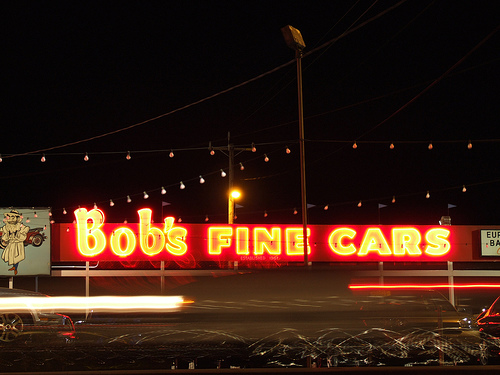Auto Advertising 2.0
RED BANK, N.J.:The disintegration of auto ad revenues this year is common knowledge. The category is tracking a 20-plus percent decline across the broadcast medium for the year. Segment performance going forward is less clear. Adam Armbruster has some ideas. Armbruster is a senior partner with ESA & Co., a firm specializing in broadcast TV ad campaign strategies.
“Growth opportunities will develop for television sales managers who understand the new paradigm in the auto business,” Armbruster writes in “Driving Automotive Forward.”
A passel of factors illustrate this new paradigm. Auto dealers emerging from the downturn will consist primarily of large investors with multiple locations. Service centers will rise in the ashes of dead dealerships and require distinct ad campaigns. Auto ads will become more strategic and less entertaining; the guy in tights and a cape will give way to a prominently displayed URL.
FEWER DEALERS, MORE BRANDS
Wind-sucking auto makers are axing several thousand dealerships over the next year. The immediate effect on vendors is a correlative increase in leverage. Armbruster says surviving dealers will play harder ball with TV ad sales pros. At the same time, car lot consolidation will create inexperience with acquired nameplates, which have increased per dealership by 50 percent over the last decade. Chrysler now peddles a slate ranging from Jeep Rubicons, Sprinter vans and Dodge Rams to Sebring convertibles, Vipers and PT Cruisers.
The company was purchased out of bankruptcy earlier this year by Fiat, which makes cars sharing zero commonality with Chrysler’s nameplates. Auto industry consultant Tom Libby told the Pittsburgh Post-Gazette that Chrysler’s portfolio is “all over the map. They have to decide what their message, their buying proposition will be.”
Armbruster says likewise. Prospective buyers want to know how to stretch dollars. Savvy dealers will need to focus on “value-based tactics,” and leverage text messaging, e-mail, social media and Web chat capabilities. He stresses the importance of including a car dealer’s URL on a TV ad, “especially near the end. Strong evidence exists that interested consumers will pay a visit.” Relying on random searches or paid, third-party sources like Google AdWord and Cars.com can lead people to other dealerships.
BROADCAST VS. CABLE
Armbruster contends that local broadcast advertising is the most effective strategy for car dealers.
“A dealership owner that expects a sustained surge in response from a small cable television micro targeted ad insertion is not being realistic,” he writes. “In many television markets, the program audience for ad insertion cable networks does not register even 1,000 viewers each over specific time periods. For an auto dealer to expect immediate return from an audience of 1,000 viewers is to ignore the fact that only 1 percent of these audiences are actually in the market to buy a new car, with an even smaller portion of that 1 percent in the market for specific nameplates. Reaching car buyers market-wide, less than 10 at a time, is simply not a cost-efficient way to market on television.”
Customer acquisition costs should be measured by cost per thousand (CPM) rather than cost per spot, he says, noting that local cable insertion can cost as much as $50 to $200 CPM, while local broadcast CPMs range from $5 to $20.
Armbruster goes on to outline ad campaign strategies, including frequency and placement. The most effective frequency range is three to five times per weekly flight, and no more than eight before the message is modified. Timing is also a factor. He sites a Honda dealership that saturated early morning news shows to reach working women, and then used the Web to market to the same professionals throughout their workday.
“Negotiating very low spot rates will prove useless in a world where television campaigns will need to be timed to the proper day and hour to be effective. Fixed position scheduling and messages will be critical,” he said.
-- Deborah D. McAdams
(Cover image by Heather Phillips, story image by Curtis Gregory Perry)
More on the auto industry and broadcasting:
“Driving Automotive Forward” is available at ESA & Co.
“U.S. Automakers Are Seeking Long-term Success in a New Economic Landscape,” at the Pittsburgh Post-Gazette
June 3, 2009: “Automaker Bankruptcies Evident at Upfronts”
“Traditionally the upfronts have been key to automakers, who were reliably eager to get the best deal for spots to promote new models that come out each October… but this year no one knows how much the Big Three will be able to pay.”
May 13, 2009: “GM, Chrysler Prepare to Cull Dealerships”
Car and truck dealerships comprised the fourth largest spot-spending category among the top 100 TV markets last year, contributing $801 million of a $16.5 billion total. Now their ranks are in dire jeopardy.
May 1, 2009: “Chrysler Seeks Chapter 11 Reorganization”
After Chrysler filed for Chapter 11 reorganization Thursday, it’s unclear what happens with its relationship with Sirius XM. Sirius is offered as either standard or an in-dash factory option with a free one-year subscription in several new Chrysler models.
April 30, 2009: “Fiat Takes a Bankrupt Chrysler”
Fiat agreed to take Chrysler after the American carmaker filed for Chapter 11 today. The car maker is one the biggest advertisers in country, spending nearly $1.4 billion on advertising in 2006--the last year it was among the top 10 spenders at No. 7. The event marks the first time a major U.S. automaker files for bankruptcy.

Get the TV Tech Newsletter
The professional video industry's #1 source for news, trends and product and tech information. Sign up below.
